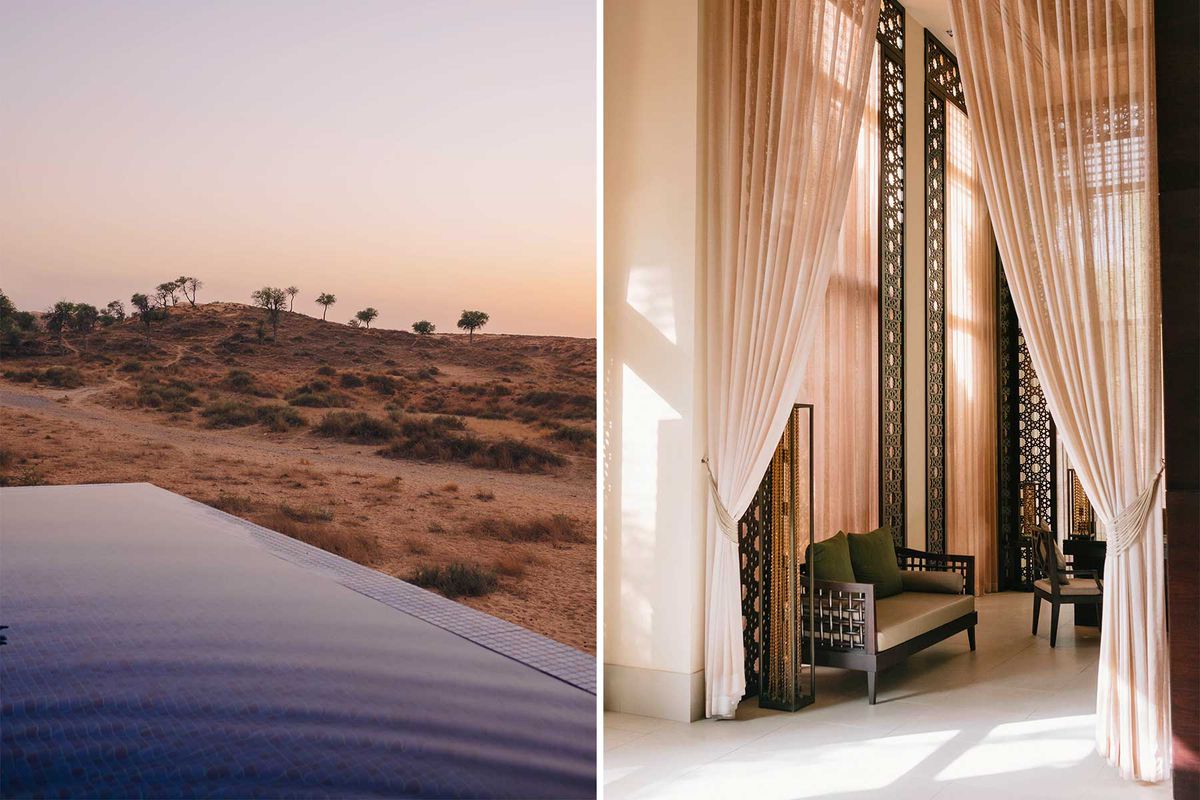Jamil and I on top of a sand dune somewhere in the Al Wadi Nature Reserve, peering at the rings of Saturn through the lens of a powerful telescope. Our stargazing guide, Wilson Ukara, recounted Arabian myths and legends about the constellations overhead as the North Star shone in the sky to our right. For generations, it served as an important signpost for Bedouin riding through this desert. Today, it is a reminder that our problems are perhaps minor in the grand scheme of things.
“Did you hear that?” Ukara asked.
“I can’t hear anything,” my husband answered.
“Exactly.”
As we rode an electric golf cart back to our hotel room, a snow-white oryx stood in our path and posed for photos in the headlights. In the serene desert night, the urban sprawl of our home in Dubai seemed a world away.
Three days earlier, with the U.A.E. starting to open up, we had made the drive to Ras Al Khaimah for a much-needed weekend retreat after months at home with our two kids. The northernmost of the seven United Arab Emirates, R.A.K. is known as a quiet enclave — easily accessible from Dubai or Abu Dhabi — with a history that stretches back nearly 7,000 years.
Our introduction to the emirate was Al Jazirah Al Hamra, “the Red Island.” This former tidal island is home to a 200-year-old ghost town with hundreds of abandoned stucco houses that once supported a bustling community of pearl divers. Trading ports like these used to sustain the emirate. Portuguese, Dutch, and Persian influences — present in the architecture and in the spices — remain from the era when this was labeled the Pirate Coast. So do hints of occupation by the British, who were lured there in the 1820s by the territory’s strategic coastal location and its lucrative pearl industry. But a century later, the local pearl market collapsed as cultivation in Japan took off — and took over. The local Za’ab people, who had originally settled the area, were forced to find a life elsewhere.
Al Jazirah Al Hamra faces the Persian Gulf, just a short distance from a cluster of upscale resorts that line the beach. We could smell the salty sea air as we looked over the low roofs of the empty houses. At the very end of the main strip is the Ritz-Carlton Ras Al Khaimah, Al Hamra Beach, where we took a small boat to the secluded, sandy spit where the property’s 32 villas are located. A nod to R.A.K. history was evident in the design of our room, which had tentlike interiors inspired by Bedouin architecture and a blue-tiled, infinity-style plunge pool. For dinner at Shore House, the hotel’s seaside restaurant, we shared a platter of Arabian-spiced octopus, lobster, and tiger prawns as we looked out over the turquoise water.

From left: Jebel Jais, the highest peak in the U.A.E; Mohammed Bin Salem Mosque, in the city of Ras Al Khaimah, the emirate’s capital. | CREDIT: ANNA NIELSEN
Just as in the rest of the Gulf, R.A.K.’s traditions are deeply rooted in the sea. A trip to Al Mairid fish market the next day revealed dozens more varieties of local seafood, from hard-shell blue crab to glistening snapper with bright-yellow fins. Wooden dhows danced on the water as fishermen carried nets brimming with the morning’s still-moving catch. We drove on to the nearby Mohammed Bin Salem Mosque, the emirate’s oldest house of worship, with records dating back to the 16th century. It was recently restored to include a new women’s section and now incorporates marine elements into its design: coral, beach rock, and beams made of mangrove wood.
An effort to revive R.A.K.’s maritime industry has been led largely by Suwaidi Pearls. Founded by Abdulla Al Suwaidi in 2005, it’s the first cultured pearl farm in the Arabian Peninsula. Jamil and I visited its base at the foot of the Hajar Mountains, from where we set off on a pearl harvesting expedition on the Gulf. Sitting cross-legged on a dhow with birds circling low over my head, I watched a diver retrieve an oyster and use a knife to pluck out a perfect pearl, holding it up to the light. It shone like a miniature moon.
Driving inland along a winding road, we passed groups of wandering camels on our way to Ritz-Carlton’s other Ras Al Khaimah property, Al Wadi Desert. The resort is surprisingly green, built around a palm garden in a natural oasis. (There’s even a hydrotherapy “rainforest experience” at the spa.) Still, as we ascended the wooden steps to our villa, it was clear we were in the desert. Our V-shaped suite mirrored the structure of Bedouin tents, but with spacious bathtubs and glass walls on three sides. Around us was a sea of sand.

From left: The pool at the Ritz-Carlton Ras Al Khaimah, Al Wadi Desert; the entrance to the hotel’s spa. | CREDIT: ANNA NIELSEN
The resort makes it easy to get out and explore the surrounding 1,235-acre nature reserve, with socially distant activities ranging from falconry to horseback riding through the dunes. But for us two working parents, the allure of lazing on sun beds by our private desert-facing pool was too hard to resist. We watched the sun set over the golden dunes as the occasional curious gazelle passed by to say hello. Our stargazing excursion could wait until tomorrow.
Over dinner at on-site restaurant Farmhouse, which sources ingredients from the resort’s garden, we plotted a return with our kids. Next time, our plan is to drive up Jebel Jais — the tallest mountain in the U.A.E. — to take a ride on its record-breaking zipline. But that night, we were content with a midnight swim, tracing constellations in the water with our fingertips.
This story first appeared in the December 2020 issue of Travel + Leisure under the headline “Sea of Tranquility.”
Source: travelandleisure.com

























